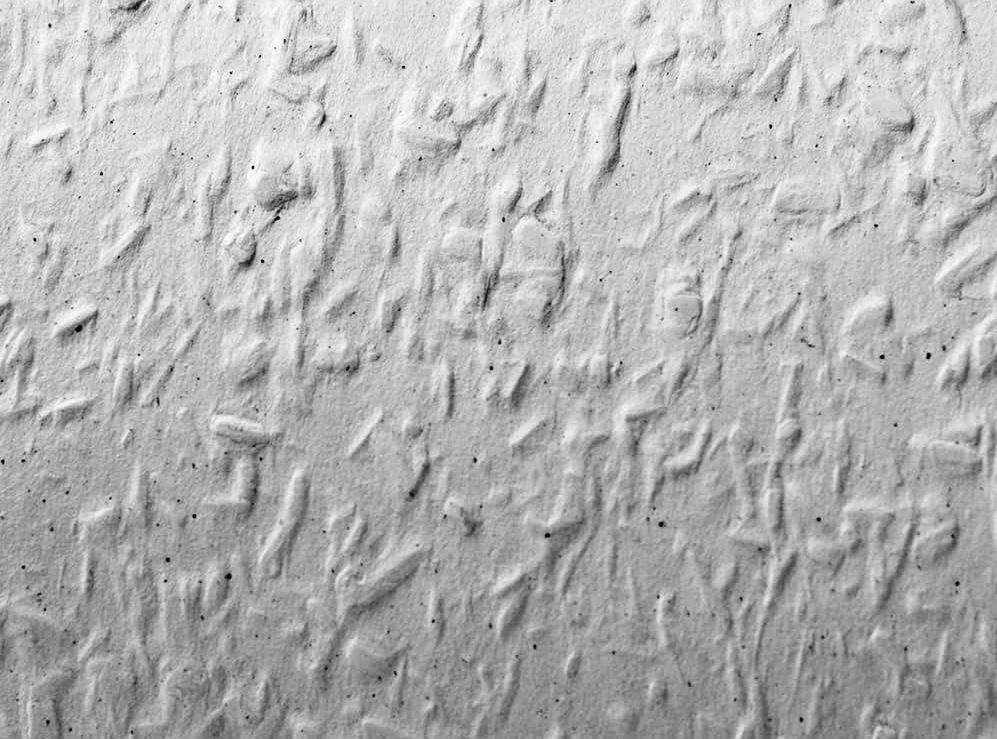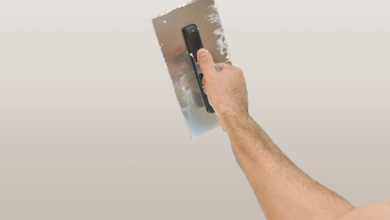Wallpaper Over Woodchip

The 1970s and 1980s saw a lot of popularity for woodchip wallpaper. Some homes have woodchip on the walls, even though that was decades ago.
If you recently moved into a new home or are renting and you see woodchip, you might want to consider wallpapering over it.
Adding wallpaper to your walls is a simple way to hide flaws and make your interiors look beautiful. But the woodchip isn’t the usual surface on which wallpaper would stick.
As a result, you might be unsure if the wallpaper will adhere. Today, we’ll talk about whether wallpapering over woodchip is feasible and, if so, how to do it effectively.
Is Wallpapering Over Woodchip a Good Idea?
Professionals in this field will tell you that wallpapering over woodchip is not recommended. The surface will have noticeable lumps when papering woodchips, which is an issue.
The best course of action is to remove the wallpaper and apply a skim coat if you don’t like the way that chipped wallpaper looks. After that, you can paint the walls or apply your favorite wallpaper.
But if you paper over a woodchip, it will look horrible because the chips will lump together on the new wallpaper.
Wallpapers aren’t They Designed To Cover Woodchip?
However, you should be aware that some manufacturers produce wallpaper intended to cover woodchip before giving up on the idea of using wallpaper to hide it.
We’re not talking about your average wallpaper here; rather, we’re talking about wallpaper that has been specially made to take in the textured surface of the woodchip and leave the top smooth. The Wall Doctor is one type of such wallpaper.
Woodchip wallpaper was created because it is a challenging material to remove. For those who wish to remove the woodchip wallpaper from their walls, this is an easy solution. This wallpaper has a woodchip backing, and adhesive is included to help you join the two.
There are other manufacturers of woodchip-covering wallpaper besides Wall Doctor. There are other brands available. You only need to look.
To find out how well these wallpapers work to hide woodchip, it’s a good idea to do a patch test on a small area first.
Additionally, the majority of wallpapers designed to cover woodchips come in basic colors that some of you may find boring, in contrast to regular wallpapers that come in a variety of styles and patterns. There aren’t many alternatives or choices.
Is Thick Wallpaper Usable?
It can also seem like a great idea to cover woodchips with thick wallpaper. You should use caution when using this method, though.
The woodchips underneath will be readily visible on thin wallpaper. However, a thicker wallpaper will cover these chips, and it should adhere strongly if you use a strong adhesive.
The weight of thick wallpaper is its main drawback. Woodchip wallpaper was popular in the 1970s and 1980s, as was previously mentioned. Thus, it is primarily prevalent in older homes.
The plaster in a house like this has been there for many years and is not very sturdy. The plaster underneath the thick wallpaper may come off with the woodchip when you apply weight to it.
Even though thick wallpaper is great for concealing woodchips, you should be aware that applying thick wallpaper to old plaster poses risks.
What Would Make Wallpapering Over Woodchip Appealing to You?
A homeowner would think about wallpapering over woodchip for two main reasons. They object to the woodchip design, which is the first justification.
Everybody has different preferences. Some like woodchip and others don’t. You most likely don’t like the woodchip if you’re looking into ways to wallpaper over it.
You might also be interested in wallpapering over woodchip because it is more difficult to remove. If you’ve attempted to remove the woodchips from your walls, you are aware of how challenging and time-consuming the process is.
You can avoid doing the woodchip removal when using wallpaper. After covering the woodchip with a fresh layer of wallpaper, you’re done. Unfortunately, the protruding portions of a woodchip cannot be hidden by most standard wallpapers.
Will Plaster Drop Out When Woodchips Are Removed?
In an old house, you can remove the woodchip and the plaster will come off easily. When woodchip wallpaper is applied to walls for an extended period of time, the woodchip integrates into the structure that stabilizes the plaster. That explains why, when you remove the woodchip, some of the plaster will come off.
We are aware that replastering requires financial investment and time. However, it’s time for a home renovation if the plaster on your walls is so thin that it can come off when you remove wallpaper.
You are also steering clear of the inevitable. One day, you’ll be able to lean against the walls and place heavy objects against them without the plaster falling off.
Which Way Is Better For Handling Woodchip?
Applying fresh wallpaper to woodchip is merely a short-term fix. Eliminating woodchips completely is the best solution if you don’t like them in your house.
If it’s a rental, covering with wallpaper is an easy and affordable way to hide the woodchip. However, to obtain a stronger and more resilient finish, it is preferable to remove the woodchip and repaint the walls if it is your house. On a freshly plastered wall, you can confidently install wallpaper without fear of it coming off.
Here’s a quick tutorial on how to remove woodchip wallpaper if you want to go the suggested route. You should be aware that it’s a stressful process and that it would be best to enlist assistance.
- Step 1: Compile the necessary supplies. A wallpaper scoring tool and removal gel are required. Both of these tools are available from a reliable retailer like Zinsser’s. A wallpaper scraper is the final item needed.
- Step 2: To expedite the removal process, use your scoring tool. Most people would use scissors or a knife, but that would take a very long time. There’s also the chance of doing harm to the wall below.
- Step 3: Use the wallpaper removal gel. This will facilitate the wallpaper removal process. You might be thinking of using water now.
However, if you mix wallpaper paste and wood chips with moisture, the outcome might be untidy. Enzymes found in specialized wallpaper removal gels effectively break down the wallpaper paste.
All you need to do is mist the woodchip wallpaper with it and give it a few minutes to dry. It will come off the wallpaper rather easily when you return to remove it.
- Step 4: There may be some residue left on the wall if the woodchip wallpaper has been there for a while. And this is where a scraper’s function enters the picture. All remaining woodchips will be completely removed by the scraper.
To prevent breaking the plaster, it would be ideal if you used the scraper very lightly. However, if you have decided to replaster the walls. You are free to act in a rough manner. Just be careful to tuck a bag under the walls to avoid scrubbing the space.
Is It Cost-Effective to Apply Wallpaper Over Woodchip?
Out of all the options, wallpapering over woodchip is the least expensive. However, unless you purchase the unique wallpaper made specifically for use on woodchip, it is the least effective.
The only expense associated with this option is purchasing the wallpaper, which you can install yourself to save money.
However, it will take more time and materials to remove the woodchip and repaint the walls. Costs would rise as a result of that.
For rental properties, we advise wallpapering over woodchip since the alternatives are more expensive. However, to reinforce the structure of your home during renovations, remove the woodchip finish and repaint the walls if you so choose.
Woodchip Painting vs. Wallpapering
Painting over a woodchip wall is another way to fix it. If you’re a homeowner and want to hide the woodchips, you might have to choose between painting and applying wallpaper.
Now that we’ve covered the advantages and disadvantages of wallpapering over woodchip, let’s take a closer look at painting.
Paint can be applied over woodchip. However, you must verify the age of the walls and the number of paint applications on the woodchip. Starting with the latter, if the woodchip has been painted multiple times, it might no longer be absorbent.
As a result, fresh paint won’t have anything to stick to. There can be adhesion problems if the walls are quite old. Moreover, the plaster may come off.
The lumps on the woodchip cannot be concealed by paint, which is the other issue. You have to spray really thick coats to achieve this.
Woodchip wallpapers that were put in years ago may have that issue. Furthermore, accuracy and skill are needed for a thick paint job. Something that most DIYourselfers lack.
Removing the old woodchip and repainting the walls is not comparable to painting or applying wallpaper over woodchip.
These two represent quick cuts. It is preferable to remove the woodchip and plaster from your home rather than painting or wallpapering it if you are serious about remodeling.

